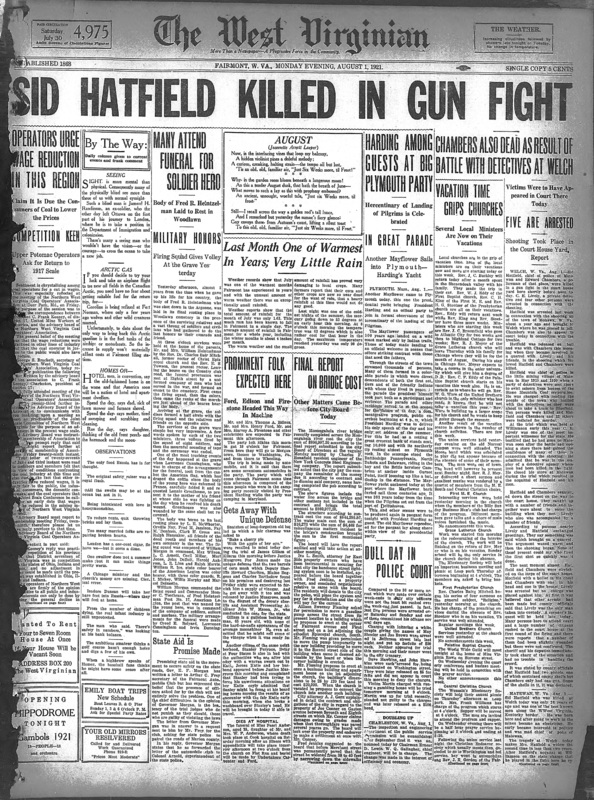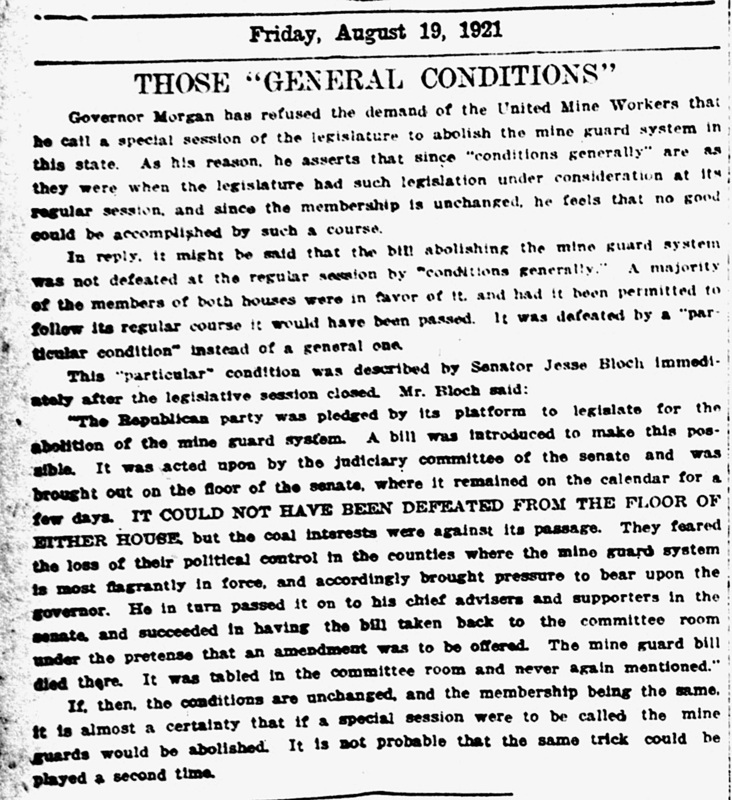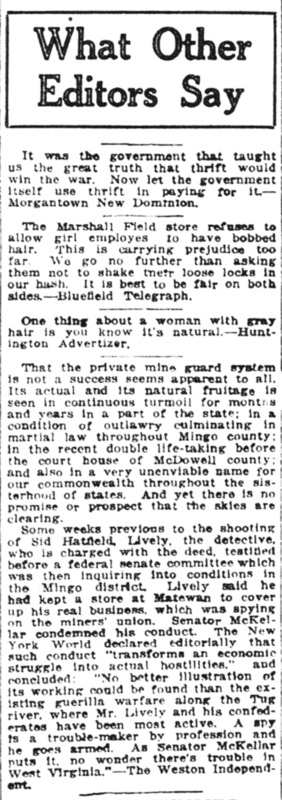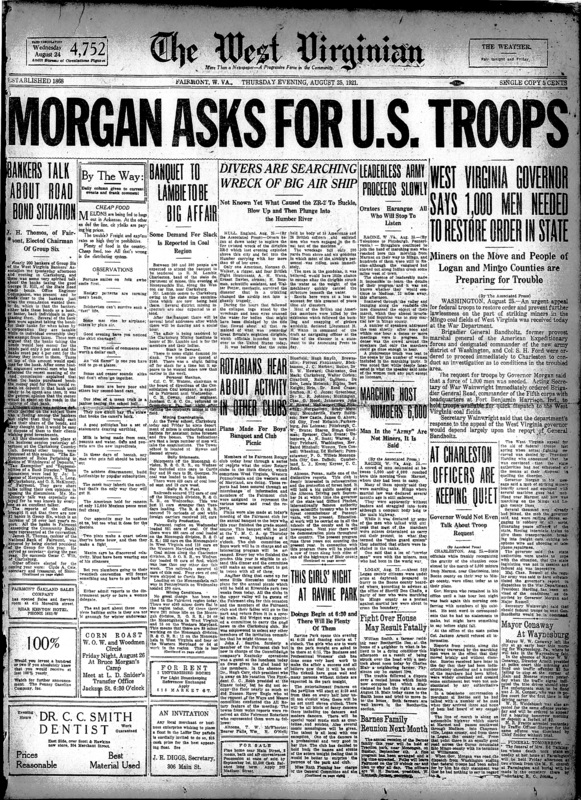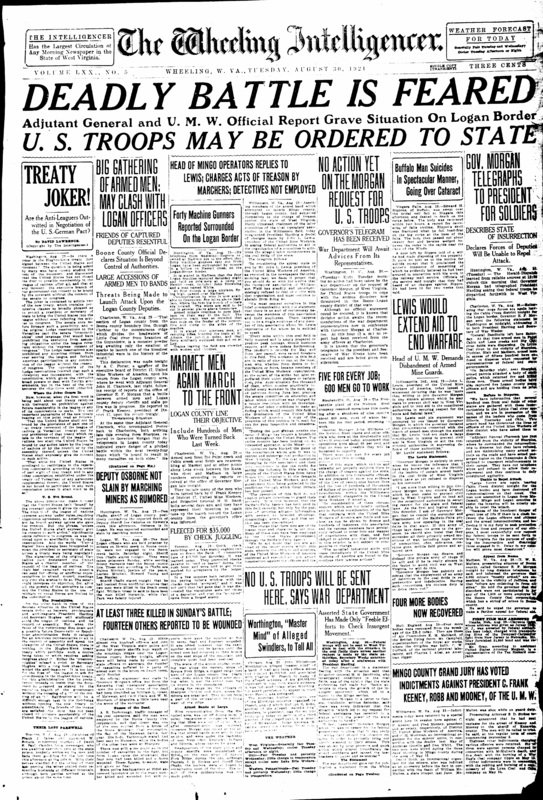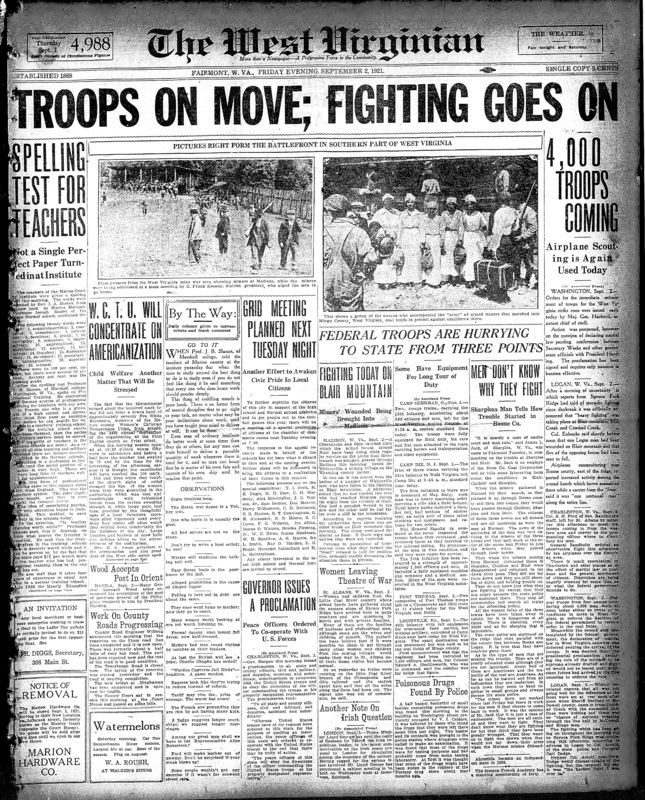West Virginia Newspapers
"Sid Hatfield Killed in Gunfight"
In an article titled “Five are Arrested,” this newspaper opens to the public sphere the terrible situation that ended in the deaths of Sid Hatfield and Edward Chambers in the courthouse yard. In this shooting, C. E. Lively and four other persons were arrested in connection with the shooting. Sid Hatfield was only 26 years old, acting Chief of Police in the village of Matewan, and was one of the best known men in the border of West Virginia and Kentucky. Prior to the gunfight that ended the lives of Hatfield and Chambers was an exchange between Lively and Hatfield. Words were exchanged, and the next moment they were in an argument. As early as August, the mine union situation was becoming heated and lives were beginning to be lost. This is only the start to what ended in what is known as the Battle of Blair Mountain.
"Those General Conditions"
This article was important because it shows to us that the Government felt more inclined to hold political control over the mine guard system rather than adhere to the needs of its coal miners. The United Mine Workers at this time were urging for better working conditions, but Governor Morgan refused this demand because the membership of the United Mine Workers had not since changed and felt that no good would come of abolishing the mine guard system. As quoted within this article, “They feared the loss of their political control in the counties where the mine guard system is most flagrantly in force, and accordingly brought pressure to bear upon the governor.” Following this account, the mind guard bill died at the hands of the committee and was never again mentioned. This is an exemplary artifact that lends a hand in supporting the claim that the Government had its best interest in mind at all times, even when the lives and welfare of the miners was at stake.
"What Other Editors Say"
In the last section of this passage from the Wheeling Intelligencer, Lively, a detective charged with the murder of Sid Hatfield, testified in court claiming that he had kept a store at Matewan in an attempt to inquire about the general conditions in Mingo County by spying on the minders’ union. However, Senator McKeller condemned this conduct stating that “a spy is a trouble maker by profession and he goes armed. No wonder there’s trouble in West Virginia.” This exemplifies that rather than taking effort to support and change the conditions that the miners were in, authorities would rather pin miners off as dramatizers who weren’t experiencing any oppression at all and that their last attempt in changing their working conditions was a behavior known as “thuggery” or foolish.
"Morgan Asks for Troops"
Governor Morgan sent a request for 1,000 troops to be available for quick dispatch to the West Virginia coal fields. In this article, miners were pinged as “a mop of striking miners heavily armed and equipped with several machine guns.” The governor said that these men were shooting at citizens, engaging in robbery, disarming peace officers, and more “thug-like” behavior. He also went on to claim that state authorities were unable to cope with the situation.
"Deadly Battle is Feared"
When Gov. Morgan telegram in a request for more defense by U.S. Troops, the War Department waited to respond until it heard from its representatives. Gov. Morgan requested this help in an attempt to cope with, as this article puts it, the disorders that threatened the Boone-Logan County districts of West Virginia. The War Department responded to this call for help by Gov. Morgan with a rejection in sending troops to the state. Brigadier General H. H. Bandholts felt that the states had made but “feeble attempts” to check the insurgent movement, basically saying in other words that the state did not put all its effort into addressing the situation prior to calling for help from the War Department.
"Troops On Move; Fighting Goes On"
Newspapers during this time altered in their framing of the miners and the Government. In some stances, the miners are “poorly educated class” and “making trouble.” It was noted that these areas were dangerous at all times. While true, the media portrayed the miners as fighting with excitement but not reason. They claimed the miners had no reason for their fight, and that they were taking matters into their own hands to respond violently to pursue state police. The Government, as shown in these newspaper artifacts, is always shown to the media in a positive light as trying to “restore order in the coal fields.” The Federal Government orders for the immediate call in of troops by use of airplanes to scout during the “heavy fighting” in which a declaration of martial law had been pending conferences and required issuance to become effective.
